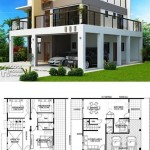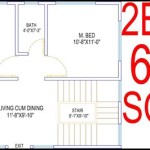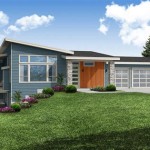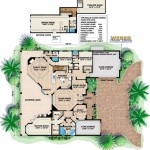A mini house plan refers to a set of architectural blueprints and instructions used to construct a compact residential structure, typically ranging from 100 to 400 square feet. These plans prioritize efficient space utilization, sustainability, and affordability, making them a popular option for individuals seeking smaller, more affordable living arrangements.
Mini house plans find application in various scenarios. For instance, they are commonly used in the construction of tiny houses, which are small, portable dwellings that offer a minimalist lifestyle and reduced environmental impact. Additionally, these plans are employed in the design of granny flats and accessory dwelling units, which are smaller secondary structures built on the same property as a primary residence.
With a focus on maximizing functionality and minimizing costs, mini house plans offer a unique approach to homeownership, catering to those seeking a simplified and eco-conscious lifestyle.
When considering a mini house plan, it’s important to keep in mind several key points:
- Compact design
- Efficient space use
- Sustainability
- Affordability
- Customization options
- Building codes
- Zoning regulations
- Resale value
- Lifestyle compatibility
Understanding these aspects will help you make informed decisions throughout the planning and construction process of your mini house.
Compact design
Compact design is a defining characteristic of mini house plans, emphasizing efficient use of space and functionality within a limited footprint. This approach prioritizes thoughtful placement of rooms, furniture, and appliances to maximize livability while minimizing wasted space.
- Maximizing vertical space: Compact designs often incorporate lofts, built-in storage, and other vertical elements to utilize the full height of the structure. This allows for additional sleeping, storage, or living areas without increasing the overall footprint of the house.
- Multi-functional spaces: Mini house plans often feature multi-functional spaces that serve multiple purposes. For example, a living room might also function as a dining area or a bedroom might incorporate a workspace.
- Built-in furniture: Custom-built furniture, such as murphy beds, fold-away tables, and banquette seating, can be incorporated into the design to save space and provide additional functionality.
- Decluttering and minimalism: Compact living promotes a decluttered and minimalist lifestyle, encouraging residents to their belongings and focus on the essentials.
By embracing compact design principles, mini house plans offer a comfortable and functional living experience within a smaller footprint.
Efficient space use
Efficient space use is paramount in mini house plans, as it allows for comfortable and functional living within a limited footprint. Mini house designers employ various techniques to maximize space utilization, creating homes that feel both spacious and cozy.
- Open floor plans: Open floor plans eliminate unnecessary walls and partitions, creating a more spacious and cohesive living area. This approach allows for natural light to penetrate deeper into the house and provides greater flexibility in furniture arrangement.
- Vertical storage: Mini houses make the most of vertical space through the use of lofts, built-in shelves, and vertical organizers. These elements provide ample storage without taking up valuable floor space.
- Multi-purpose furniture: Furniture plays a crucial role in space utilization. Mini house plans often incorporate multi-purpose furniture, such as ottomans with built-in storage, sofa beds, and tables with extendable leaves, to maximize functionality and save space.
- Smart storage solutions: Mini house plans often incorporate clever storage solutions, such as under-bed drawers, wall-mounted organizers, and hidden compartments, to keep belongings organized and out of sight.
By implementing these space-saving techniques, mini house plans create homes that are both compact and comfortable, allowing residents to live efficiently and sustainably.
Sustainability
Sustainability is a key consideration in mini house plans, as these homes aim to minimize their environmental impact and promote eco-conscious living.
Energy efficiency: Mini house plans prioritize energy efficiency through the use of insulation, energy-efficient appliances, and renewable energy sources. This reduces energy consumption and lowers utility bills, contributing to a greener lifestyle.
Reduced carbon footprint: Due to their smaller size and energy efficiency, mini houses have a reduced carbon footprint compared to larger homes. This contributes to mitigating climate change and preserving the environment.
Sustainable materials: Mini house builders often opt for sustainable and eco-friendly materials, such as recycled or reclaimed wood, bamboo, and cork. These materials have a lower environmental impact and contribute to a healthier indoor environment.
Water conservation: Mini houses often incorporate water-saving fixtures and appliances to minimize water consumption. Rainwater harvesting systems can also be implemented to collect and utilize rainwater for non-potable purposes.
Waste reduction: Compact living encourages a minimalist lifestyle and reduces waste production. Additionally, composting systems can be incorporated to manage organic waste and promote nutrient recycling.
Affordability
Affordability is a primary advantage of mini house plans, making them accessible to a wider range of individuals and families.
Lower construction costs: Mini houses require less materials and labor to construct compared to larger homes. This translates to significant savings on construction costs, making them a more affordable option for homebuyers.
Reduced land requirements: Mini houses have a smaller footprint, requiring less land for construction. This can lead to savings on land acquisition costs, particularly in areas where land is scarce or expensive.
Energy efficiency: The compact size and energy-efficient features of mini houses result in lower energy consumption and utility bills. This ongoing savings contributes to the overall affordability of mini house living.
Lower maintenance costs: Mini houses have less square footage to maintain, leading to lower expenses for repairs, cleaning, and general upkeep. This reduces the financial burden on homeowners and contributes to the long-term affordability of their homes.
Customization options
Mini house plans offer a range of customization options to suit individual preferences and lifestyles. Homeowners can tailor their homes to meet their specific needs and desires, creating truly unique and personalized living spaces.
- Layout and design: Mini house plans can be customized to accommodate different layouts and designs. Homeowners can choose from various floor plans, window and door placements, and interior configurations to create a space that aligns with their functional and aesthetic preferences.
- Finishes and materials: Mini house plans allow for customization of finishes and materials. Homeowners can select from a wide range of options for flooring, countertops, cabinetry, and fixtures to create a home that reflects their personal style and taste.
- Appliances and systems: Mini house plans can be customized to include the appliances and systems that homeowners desire. This includes the selection of energy-efficient appliances, solar panels, smart home technology, and other features that enhance comfort, convenience, and sustainability.
- Outdoor spaces: Mini house plans can incorporate customized outdoor spaces, such as decks, patios, or porches. These spaces extend the living area and provide opportunities for relaxation, entertainment, and connection with nature.
By offering these customization options, mini house plans empower homeowners to create unique and personalized living spaces that meet their specific needs, preferences, and aspirations.
Building codes
Building codes are essential regulations that govern the construction, alteration, and maintenance of buildings to ensure public safety, health, and welfare. Mini house plans must adhere to these codes to ensure the structural integrity and safety of the dwelling.
- Zoning restrictions: Zoning codes regulate the use of land and specify the types of structures that can be built in different areas. Homeowners should check local zoning regulations to ensure that mini houses are permitted on their property and comply with any size or height restrictions.
- Building permits: Building permits are required for the construction of any new structure, including mini houses. The permit process involves submitting plans for review and approval by the local building department to ensure compliance with building codes and zoning regulations.
- Structural requirements: Building codes specify minimum standards for structural elements, such as foundations, framing, and roofing. These requirements ensure that the structure is safe and can withstand anticipated loads, including wind, snow, and earthquakes.
- Safety features: Building codes also mandate the inclusion of safety features, such as smoke detectors, carbon monoxide detectors, fire extinguishers, and emergency exits. These features help protect occupants in case of emergencies.
Understanding and adhering to building codes is crucial for ensuring the safety and legality of mini house construction. Homeowners should work closely with local authorities and contractors to ensure that their plans comply with all applicable regulations.
Zoning regulations
Zoning regulations are a crucial aspect of mini house construction, as they determine the legality and feasibility of building a mini house on a specific property. Zoning laws are established by local governments to regulate land use and ensure orderly development within their jurisdictions.
Mini house plans must comply with the zoning regulations of the area where the construction is planned. These regulations typically specify the minimum lot size, setbacks from property lines, height restrictions, and allowable uses for different zoning districts. Homeowners should research the zoning regulations of their property to determine if mini houses are permitted and to understand any specific requirements or limitations.
Zoning regulations may also include provisions related to the size, design, and placement of mini houses. For example, some jurisdictions may have minimum square footage requirements or restrictions on the use of certain materials or architectural styles. It is important to carefully review the zoning regulations and consult with local authorities to ensure that the mini house plan meets all applicable requirements.
Understanding and adhering to zoning regulations is essential for obtaining building permits and ensuring the legality of mini house construction. Homeowners should work closely with local authorities and contractors to navigate the zoning process and ensure that their plans are compliant. Failure to comply with zoning regulations can result in fines, delays, or even the denial of building permits.
Zoning regulations play a vital role in shaping the built environment and ensuring the orderly development of communities. By complying with zoning regulations, mini house builders can contribute to the creation of safe, sustainable, and aesthetically pleasing neighborhoods.
Resale value
The resale value of a mini house is an important consideration for homeowners who may plan to sell their property in the future. While mini houses offer many advantages, there are factors that can affect their resale value compared to traditional homes.
- Marketability: Mini houses appeal to a niche market of buyers who are seeking affordable, sustainable, and compact living options. The marketability of a mini house can depend on the location, amenities, and overall condition of the property.
- Location: The location of a mini house can significantly impact its resale value. Mini houses located in desirable areas with access to amenities and public transportation tend to have higher resale values.
- Unique features: Mini houses often incorporate unique features and designs to maximize space and functionality. While these features can be attractive to some buyers, they may also limit the appeal to a broader market, potentially affecting resale value.
- Zoning regulations: Zoning regulations can influence the resale value of a mini house. In some areas, zoning restrictions may limit the construction or sale of mini houses, reducing the pool of potential buyers and impacting resale value.
It’s important for homeowners to carefully consider the potential resale value of a mini house before making a purchase. Factors such as location, marketability, unique features, and zoning regulations should be taken into account to make an informed decision.
Lifestyle compatibility
Lifestyle compatibility is a crucial consideration when evaluating mini house plans, as these homes require a certain level of adaptability and adjustment to a compact living environment. Mini house living offers unique advantages, but it is important to assess whether one’s lifestyle and preferences align with this type of home.
Individuals who thrive in small spaces, value sustainability, and embrace a minimalist lifestyle are well-suited for mini house living. Mini houses promote a simplified and intentional lifestyle, encouraging residents to declutter, prioritize experiences over material possessions, and embrace a more eco-conscious approach to living.
On the other hand, those who require ample space, have large families or frequent guests, or are accustomed to a more traditional home environment may find mini house living too restrictive. Mini houses may also pose challenges for individuals with accessibility needs or those who work from home and require a dedicated workspace.
It is important to carefully consider one’s lifestyle, values, and daily routines to determine if a mini house plan aligns with one’s needs and aspirations. Potential homeowners should visit existing mini houses, talk to current residents, and thoroughly research the lifestyle implications before making a decision.
Lifestyle compatibility plays a significant role in the long-term satisfaction and enjoyment of a mini house. By carefully assessing one’s lifestyle and preferences, individuals can make an informed decision about whether a mini house plan is the right choice for them.










Related Posts








